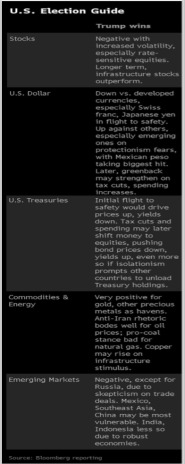The stock market’s reaction to the election surprised most analysts, and many investors have spent the past week scrambling to adjust their portfolios. I have a few investing tips to help guide you through the Trump aftermath. But first, let’s examine what’s going on out there.
Two days before the election, Bloomberg published a “cheat sheet” for investors, predicting such consequences as a decline in the U.S. dollar and higher oil and gold prices if Trump won. Here are Bloomberg’s predictions for a Trump win in full, just for entertainment value:
Except for their prediction that infrastructure stocks would outperform, most of Bloomberg’s predictions were dead wrong. The U.S. dollar is up, bonds are being treated like toxic assets, and gold prices have fallen off a cliff.
Among individual stocks, the results have been equally divergent.
Biotechs and financials are rejoicing over the prospect of lighter regulation. Old-economy industrials (think Caterpillar (CAT) or Steel Dynamics (STLD)) are soaring in anticipation of increased infrastructure spending.
On the other side of the seesaw are some strange bedfellows—growth stocks and high yield investments. The so-called FANG stocks—Facebook (FB), Amazon (AMZN), Netflix (NFLX) and Google (GOOG)—were absolutely hammered last week, while yield investments are getting dragged down in the bond selloff.
The divergences got so great last week that the Dow hit an all-time high even as the Nasdaq was selling off.
Bigger picture, such dramatic divergences usually aren’t a great sign for the market’s overall health. However, given the unusual circumstances, I wouldn’t read too much into the bifurcation yet. Post-election reactions usually last between one and five days, so it’s still likely that the market settles down and more “normal” trading resumes soon.
However, in the meantime—or if we wind up in a similar situation again soon—here are a few investing tips in a bifurcated market.
Investing Tip #1: Diversify.
Diversification can be overrated—if you own every stock in the market, you’ll never beat the market. But a little diversification goes a long way.
That means not owning too many stocks from one industry, for example. If half of your portfolio is biotech stocks, your net worth will take a big hit if a rotation out of health care stocks begins. Owning a couple of the best stocks in an industry is usually enough.
At times like these, it can also help to be diversified by risk level. Even if you’re an aggressive investor, it’s wise to hold a few more conservative positions, so you have some gainers balancing out the losses if investors suddenly shift to “risk off.” This would have helped Thursday, when fast-growing, aggressive stocks like Facebook sold off dramatically.
Conservative investments can sell off in concert too—when investors are piling into growth stocks, it’s usually equally bad news for utility stocks and “boring” dividend stocks. So it’s a good idea not to have your entire portfolio in one type of investment or the other.
[text_ad]
Investing Tip #2: Hone Your Watch List.
Sector rotation can create significant short-lived buying opportunities.
Consider the action of General Motors (GM) the day after the election. The stock initially fell 2.4% because of fears that Trump would repeal NAFTA, increasing GM’s manufacturing costs. But by the end of the next day, GM had erased all those loses and was 2.2% higher than it had been before the election. Now, it’s even higher.
These opportunities are often brief though, so having a list of stocks you’d like to buy “on sale” ready beforehand is crucial.
Investing Tip #3: Take Profits.
If the buying opportunities created by market divergences are brief, the profit-taking opportunities are even briefer. Rapid-fire rotations that bring quick profits can take them away just as quickly.
This week’s big gains in infrastructure stocks, for example, are based on anticipation of government spending that hasn’t even been proposed yet (unless campaign speeches count), never mind approved. Don’t hesitate to take partial profits when one of your holdings is benefiting from a (likely) temporary surge of investor interest.


